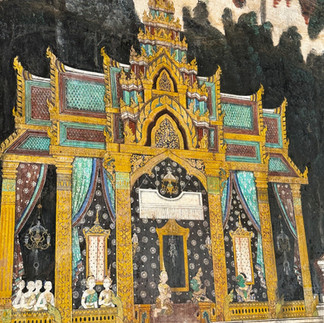Yellow: the color of the sun, the color of light … A most sacred and holy color in Asia, the buildings on the grounds of the Royal Palace of Cambodia are a pallet of all shades of yellow imaginable – from the lightest cream of fresh butter to a deep saffron … from an earthy ochres to the gold of the sun…

The palace was constructed between 1866 and 1870, after King Norodom relocated the royal capital from Oudong to Phnom Penh. It is situated at the Western bank of the confluence of the Tonle Sap and the Mekong rivers – the perfect (if not sacred spot) where the river changes direction of flow with the seasons, filling the Great Tonle Sap Lake.
The establishment of the Royal Palace in Phnom Penh in 1866 is a comparatively recent event in the history of the Khmer and of Cambodia. The seat of Khmer power in the region rested in or near Angkor (near present day SiemReap) north of the Great Tone Sap Lake from 802 AD until the early 15th century. I've read mixed reports as to why the capital moved – environmental issues, ecological imbalances, or more and more frequent attacks by the neighbouríng Thai Kingdoms that were rising and consolidating in power (see more on the Thai-Cambodian issue here) ... but the after 600 years, the Khmer moved South – first to Phnom Penh (then called Krong Chaktomuk Serei Mongkol) for circa 50 years, then to Basan, then to Longview, and then to Oudong ... and, under King Norodom in the early 1800's back to Phnom Penh.
THE THRONE HALL
The largest building in the complex is the Throne Hall. King Norodom originally had it built in wood, but it was destroyed in 1915. The present Throne Hall was reconstructed and inaugurated by King Bat Sisowath in 1919.
Its roof contains seven tiers and is marked on the top with a 59m-high four-face tower which is erected in the Bayon style. The roof (as many here) is also covered with tiles in the three colors of saffron/orange, sapphire blue and emerald green representing prosperity, nature and freedom. Golden nagas at the corners of each level protect the building from evil spirits.
Inside, there are multiple "layers" of thrones in a row ... so the King sits at the top, right? Wrong: The King sits on middle level (the one on the high pedestal) for sacred/ceremonial events, with his Queen in back of him. Below, the "Western Style" arrangement will have the King in the middle, on the throne, with his Queen to his side.

THE SILVER PAGODA
The Silver Pagoda is ... not silver. But it wasn't always that way. The interior was once covered by silver tiles – these were removed (and probably sold for weapons on the black market) by the Khmer Rouge.
The Silver Pagoda stands as part of a temple complex in a separate courtyard from the Royal Palace and is surrounded by smaller temples and gorgeous stupas.
THE COURTYARD MURALS
There are often overlooked, as people zip straight to the buildings in the courtyards, but the courtyards themselves are cloisters - covered walkways around the courtyard, and their wall are covered with endless murals. They are currently being restored, so I saw some restored and some in need of much attention and care .. but all of them an amazing story that scrolled on and on and on as you walked by ...
THE OUTSIDE WALLS
The Royal Palace is built like a fortress from the outside, although you feel nothing of that once inside. Even here, the dominant yellow is everywhere – even the sidewalks!



















































































Comments